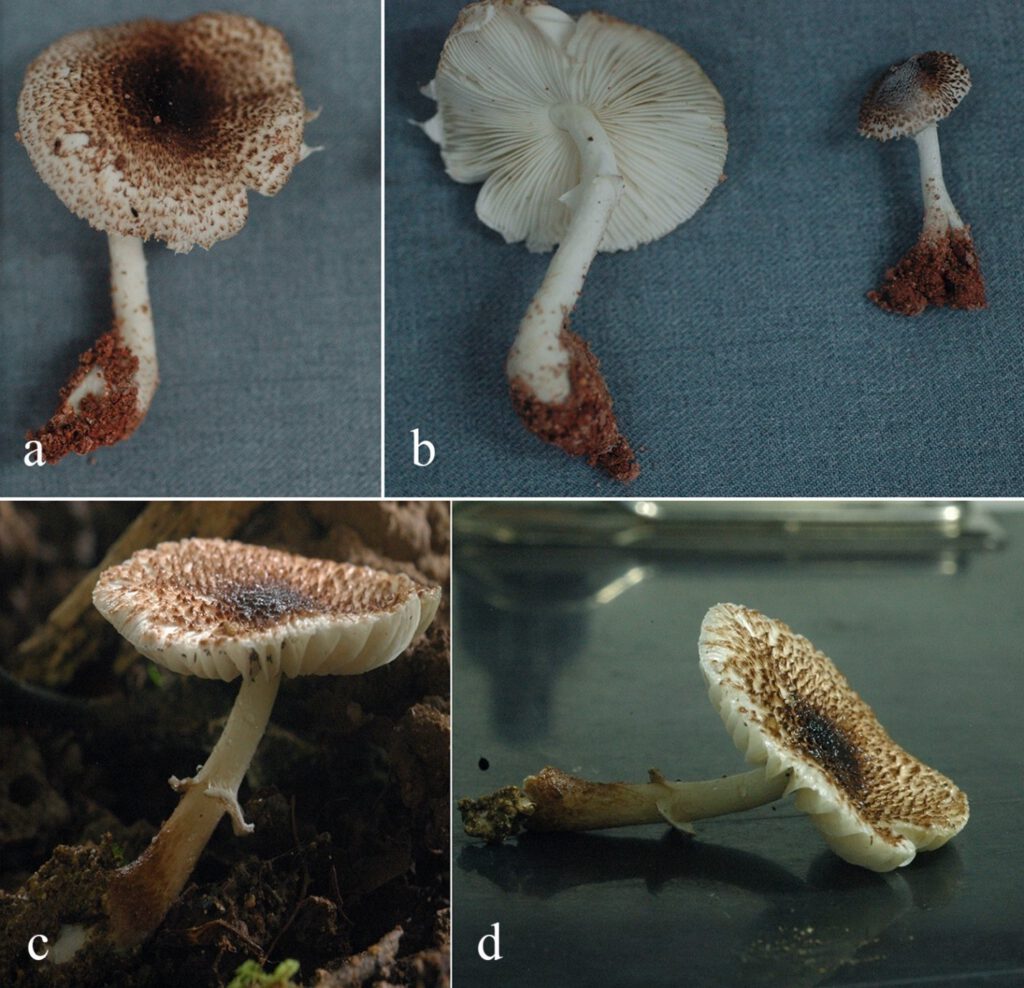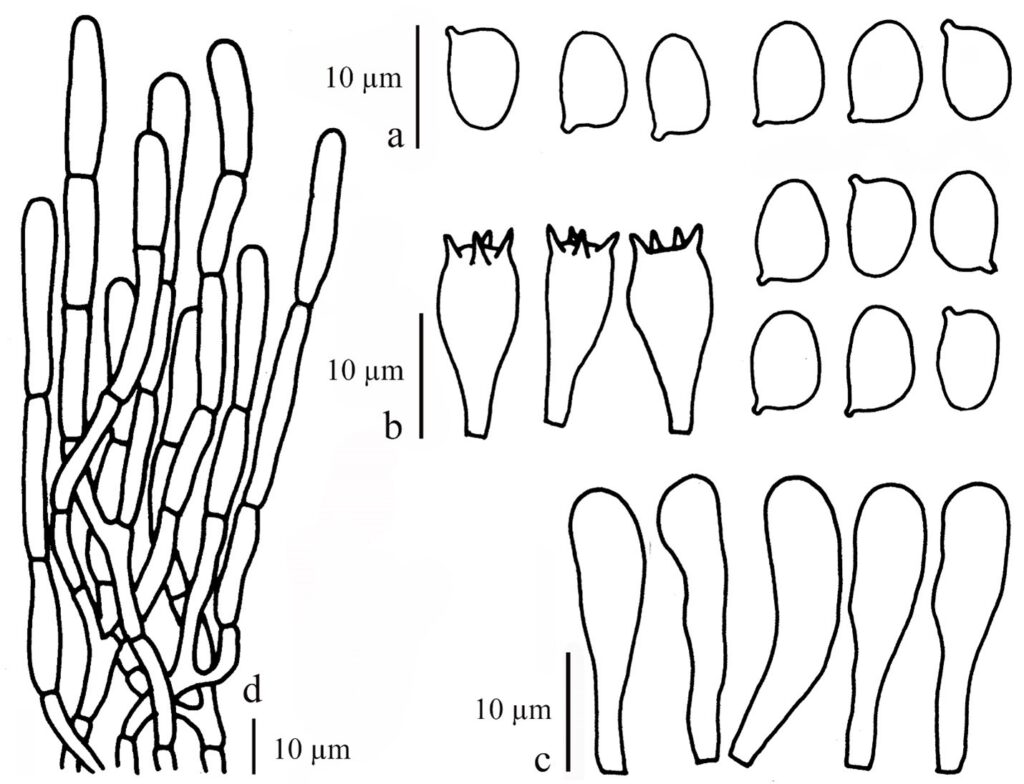Leucoagaricus laosensis
MycoBank number: MB 841760; Index Fungorum number: IF 841760; Facesoffungi number: FoF 10577;
Description
Pileus 14–29 mm diam., convex to sub-umbonate with small umbo, expanding to applanate or slightly plano-concave with low center or umbo when mature, with straight margin; with very crowded fibrillose at center or umbo, light brown to dark brown (6E4–7, 6F6–8), around center with concolorous tuff, fibrillose or fibrillose squamules with uplift tip towards margin, with white to orange-white (5A2) fibrillose background; margin with concolorous fibrillose or fibrillose squamules, sulcate and fringed when mature, with or without white to light brown (6E4–5) remnants. Lamellae free, ventricose, 4–6 mm wide, crowded, white, with concolorous eroded edge. Stipe 25–35 × 5–8 mm, wider at base and tapering to apex, bulbous 12 mm wide, with white fibrillose background, sometimes with hyaline water drops, covered with light brown to dark brown (6E4–7) fibrillose squamules from middle to base, crowded at base. Annulus attached at middle or slightly high on stipe, membranous, white, hanging down, with light brown to brown (6E4–7) fibrillose squamules at edge. Context in pileus white, up to 3 mm wide; in stipe, white, hollow. Smell soft. Taste not observed. Spore print white.
Basidiospores [50.2.2] 7.0–7.5 × 4.3–5.0 µm, avl × avw= 7.2 × 4.5 µm, Q= 1.4–1.70, Qav= 1.60, in side-view ellipsoidal to oblong ovoid, slightly amygdaliform with rounded apex, in frontal view ellipsoid to oblong, hyaline, thick-walled, dextrinoid, congophilous, cyanophilous, metachromatic. Basidia 17–20 × 7–8 µm, clavate, hyaline, thin-walled, 4-spored. Pleurocystidia absent. Cheilocystidia 20–28 × 7–10 µm, clavate to narrowly clavate, rarely cylindrical, hyaline, thin-walled. Pileus covering a trichoderm made up of cylindrical elements, terminal elements 37.5–87.5 × 12.5–15 µm, slightly thick-walled, with brown parental and intracellular pigments. Stipe covering a trichoderm made up of cylindrical elements, terminal elements 20–60 × 9–14 µm, slightly thick-walled, with brown parental and intracellular pigments. Clamp connections absent.
Materials examined: LAOS, Oudpmxay Province, Xay District, Houay Houm Village, 23 July 2014, Phongeun Sysouphanthong (HNL501782, Type); ibidem, 23 July 2014, Phongeun Sysouphanthong (HNL501802).
GenBank numbers: ITS: OK570188, OK570189 (ITS1-F/ITS4).
Notes: Leucoagaricus laosensis can be recognized by small to medium size, convex to sub-umbonate pileus and covered by light brown to dark brown fibrillose to fibrillose squamules, oblong to ellipsoidal ovoid basidiospores, clavate basidia, clavate to narrowly clavate cheilocystidia, and trichodermal structure of pileus- and stipe covering.
According to its colour of pileus covering, so rare species come to relate to Leucoagaricus laosensis. The most related species, Leucoagaricus infuscatus Vellinga from the U.S.A, is similar to Leucoagaricus laosensis by size of basidiomata (18–24 mm), and has applanate to shallowly plano-convex pileus and covered with brown fibrillose. However; differently; Leucoagaricus infuscatus has distant lamellae, smooth stipe and whitish on watery pinkish cream-colored background, narrower basidiospores (5.6–7.6 × 3.4–4.4 µm), longer cheilocystidia (26–57 × 4.0–12 µm), a cutis structure of pileus covering (Vellinga 2007). Similarly, the phylogenetic analysis of ITS data showed that Leucoagaricus infuscatus and Leucoagaricus laosensis are related together (Fig. 3).
Lepiota flammeotincta Kauffman is also related to Leucoagaricus laosensis phylogenetic analysis of ITS data (Fig. 3). Lepiota flammeotincta from the U.S.A is similar to Leucoagaricus laosensis in convex to plano-convex or applanate pileus with small and low umbo, and brown to dark brown radially arranged fibrillose squamules with uplift tip; but differs in turning orange-red to dark brown on pileus and stipe when touched, white to cream with pinkish lamellae, cuff-liked annulus, larger basidiospores (5.9–9.0 × 3.4–5.6 µm), longer cheilocystidia (25–70 × 4.5–13 µm) with mostly cylindrical and rarely narrowly clavate elements, and a cutis structure of pileus covering (Vellinga 2010).

Figure 1. Fresh basidiomata of Leucoagaricus laosensis in situ. a–b= HNL501802, c–d= HNL501782.

Figure 2. Micro-characters of Leucoagaricus laosensis (HNL501782). a= basidiospores; b= basidia, c= cheilocystidia, d= elements on pileus covering.
